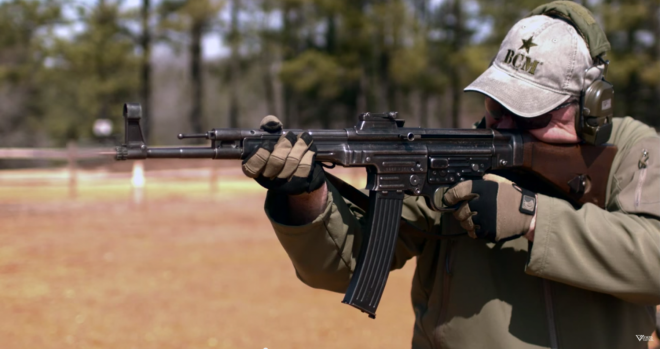The Sturmgewehr is a rifle that will never lose it’s place in history; it is one of the single most influential weapons of the 20th Century. It is not the first of its kind, however, and we at TFB have previously taken a look at some of the rifle’s predecessors that it has since overshadowed. Larry Vickers has come at it from the other end; he and his signature StG-44 have been the subject of three shooting videos so far, each one well worth watching:
A friend of mine of some expertise on the subject had this to say about the MP-43, and Larry’s videos of it:
First slow-motion video:
You can see that the STG-44 unlocks very quickly and blows a lot of flame out the ejection port, something you and I have both seen first-hand. The video is also high enough quality that you can see how muzzle and breech flash form; at 1:42 you can see that the case ejects, and then fresh air from around the ejection port flows in, which causes the hot, fuel-rich propellant gas to ignite. You can also see the magazine jiggle that LAV mentions in the next video.Second video:At 55 seconds, the video editor appears to have made a mistake with the outline of the 7.92x33mm cartridge. At about 1:10, he manipulates the safety and selector very quickly, and if you look closely you can see that they’re separate pieces. This is unusual by modern standards; he mentions this later, but the FAMAS has a separate safety and burst/auto selector. LAV says that original magazines work better, but they’re rare. Despite attempts to increase production, wartime production of magazines only ever amounted to about four per rifle. Ammunition was similarly scarce; wartime production was less than 2,000 rounds per rifle. Albert Speer, during a tour of the front, found several units that had been issued STG-44s, but no ammunition for them. A few memoirs from German soldiers mention this as well.There was an early request in 1942 after the first trials of the MKb-42H that the magazine be 15 rounds (along with the bizarre request that a “hinged stilletto which could also be used as a bipod be added!), and some early test magazines were 32 rounders, and there were also some suggestions that the magazines be 25 rounds, but the bulk wartime production magazines were 30 rounders and the late-war STG-45 ones were to be 10 rounds. LAV probably mis-spoke. Later on in the war, troops were advised to only load their magazines to 25 rounds, just as LAV discovered. A new magazine follower design, with a limiter to ensure the magazine could only be loaded to 25 rounds, was proposed, but does not appear to have been produced.The rifle was produced in fairly respectable numbers, but attempts to improve production rates were always held back by the fact that work was contracted out to 46 subcontractors, and coordinating between these during the war was very difficult. Nevertheless, various improvements to the rifle were proposed even very late in the war. Hugo Schmeisser proposed several changes, such as a simplified receiver block insert and relocated return spring inside the receiver instead of inside the stock (another weakness of the design LAV notes). There is one weapon, captured from Germany, in an American collection marked “MP45” that has the simplified receiver block insert, but little further information about this is available.
Therein lies the rub. The MP-43 was certainly mass-produce-able; the Germans made nearly half a million of them over three years. In this, it represents the first successful assault rifle design; another nation could have fully realized the weapon, bringing the “assault rifle” full term. However, the Germans – who suffered from gross mismanagement and logistics problems throughout the war – were scarcely able to provide enough ammunition and magazines for weapons familiarization of these new weapons. In this, their implementation of the design was not the resounding success it could have been.
Regardless, it cannot be said that the rifle did not have an effect on post-war thinking. Though the Americans rejected the assault rifle and the intermediate rifle cartridge, the Soviets wasted no time in adopting the idea, fielding in very limited quantities their own assault rifle before the end of the war, and eventually adopting the Kalashnikov assault rifle and finally bringing the assault rifle fully onto the world stage.
The StG-44 hasn’t lost its relevance, though. 7.92×33 ammunition is still being made in quantity, and a cache of the rifles was captured by rebels in Syria in 2012:
Interestingly, one of these rifles even saw use in a somewhat… Unusual capacity a short time later, as a remote-controlled weapons station.
It’s my contention that an essential ingredient to the assault rifle – as important if not more so than the intermediate cartridge and select-fire capability – is the ability to cheaply mass-produce the design via the most inexpensive manufacturing methods available. The MP-43 rifle itself certainly meets this criteria, and it was made in worrying quantities utilizing highly modern stamping and forging techniques, with a design that placed a premium on using as little high quality steel as possible. However, German industry stumbled in providing the rifles with enough ammunition and magazines to satisfactorily implement the system as a whole. In the sense that the MP-43’s design meets the criteria I have set, it earns the title of the “first successful assault rifle”, but in another sense, what good is a rifle without ammunition? While in this latter way it was not a total failure, I would argue that the first wholly successful implementation of the assault rifle concept came later with the fielding of the Russian Kalashnikov assault rifle.
 Your Privacy Choices
Your Privacy Choices
